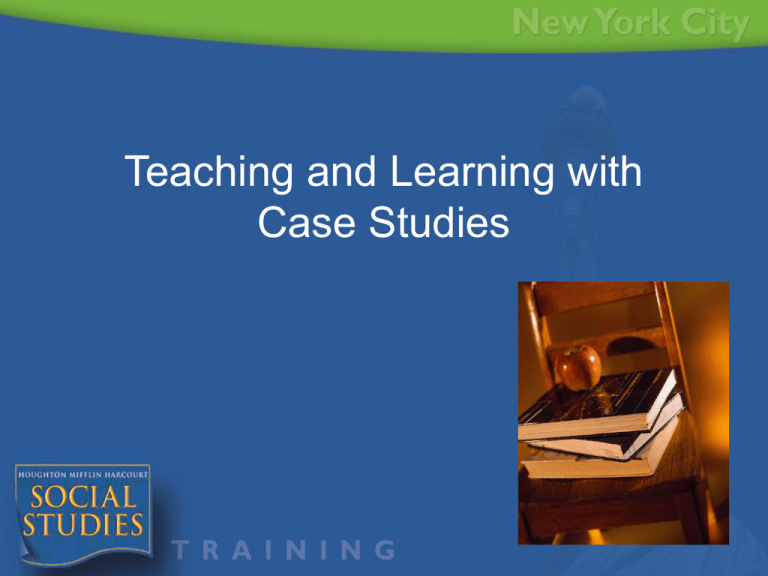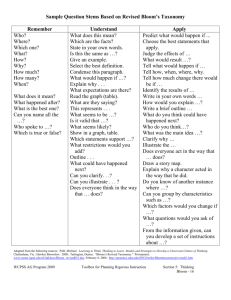Case Studies
advertisement

Teaching and Learning with Case Studies Agenda • • • • Understand how a case study is different How to effectively use a case study How to expand a case study How to replicate a case study What is the Nature of Social Studies? Social studies involves the examination of humans – our thoughts, beliefs, languages, experiences, actions, and certainly our interactions – locally to globally. What are the benefits of social studies? Social studies encompasses the philosophies, forms and functions that enable us to understand the world holistically. Social Studies allows us to successfully perform in the present, and prepares us to readily process new information and predict the future from multiple viewpoints. What are the benefits of social studies? The acquiring of social studies knowledge, skills and attitudes or dispositions helps us to achieve academically as students and to operate successfully as citizens living in an interdependent, global society. What is a case study? • A case study is an in-depth, examination of a single instance, event or group When do Case Studies Appear? Chapter 2 Lesson 2 – Lenape Chapter 3 Lesson 2 – New Amsterdam Chapter 3 Lesson 3 – English Rule in New York Chapter 8 Lesson 1 – The Melting Pot Chapter 8 Lesson 2 – Living in New York Chapter 8 Lesson 3 – New York City Expands Lesson Structure • Essential Question, Vocabulary, Reading Skill in Opener • Lesson is more than 4 pages • Includes one large graphic • Review includes Case Study Detective and Word Play activities • Case Study Journal provides extension Bloom’s Revised Taxonomy Can the student recall or remember the information? Key Words and Products • • • • • • • • • Recall List Retrieve Find Name Recognize Identify Locate Describe • Make a list of the main events . • Make a timeline of events. • Make a facts chart. • Write a list of any pieces of information you can remember. • List all the …in the story. • Make a chart showing.. • Make an acrostic. • Recite a poem Bloom’s Revised Taxonomy Can the student explain ideas or concepts? Key Words and Products • • • • • • • • Interpret Summarize Explain Rephrase Classify Infer Paraphrase Compare • Cut out or draw pictures to show a particular event. • Illustrate what you think the main idea was. • Make a cartoon strip showing the sequence of events. • Retell the story in your own words. • Paint a picture of some aspect you like. • Write a summary report of an event. • Prepare a flow chart to illustrate the sequence of events. • Make a coloring book. Bloom’s Revised Taxonomy Can the student use the information in a new way? Key Words and Products • • • • • • • • • • • • Choose Demonstrate Dramatize Employ Illustrate Interpret Operate Schedule Sketch Solve Use Write • • • • • • • • • • • Construct a model to demonstrate how it will work. Make a diorama to illustrate an important event. Make a scrapbook about the areas of study. Make a papier-mache map to include relevant information about an event. Take a collection of photographs to demonstrate a particular point. Make up a puzzle game showing the ideas from an area of study. Make a clay model of an item in the area. Design a market strategy for your product. Dress a doll in costume. Paint a mural. Write a textbook outline. Bloom’s Revised Taxonomy Can the student distinguish between the different parts? Key Words and Products • • • • • • • • • • • Appraise Compare Contrast Criticize Differentiate Discriminate Distinguish Examine Experiment Question Test • • • • • • • • • • • Design a questionnaire to gather information. Write a commercial to sell a new product. Conduct an investigation to produce information to support a point of view. Construct a graph to illustrate selected information. Make a jigsaw puzzle. Make a family tree showing relationships. Put on a play about the study area. Write a biography of the study person. Prepare a report. Arrange a party and record as a procedure. Review a piece of art including form, colour and texture Bloom’s Revised Taxonomy Can the student justify a stand or decision? Key Words and Products • • • • • • • • Appraise Argue Defend Judge Select Support Value Evaluate • Prepare a list of criteria to judge a ……..show? Remember to indicate priorities and ratings. • Conduct a debate about a special issue. • Make a booklet about 5 rules you see as important to convince others. • Form a panel to discuss views. • Write a letter to .... advising on changes needed at … • Write a half yearly report. • present your point of view. Bloom’s Revised Taxonomy Can the student create a new product or point of view? Key Words and Products • • • • • • • Assemble Construct Create Design Develop Formulate Write • Invent a machine to do a specific task. • Design a building to house your study. • Create a new product, give it a name and then devise a marketing strategy. • Write about your feelings in relation to … • Design a record, book or magazine cover. • Sell an idea. • Devise a way to … • Compose a rhythm or put new words to an old song. It’s Your Turn! • Look through an additional case study • Identify activities or questions that match each level of the Revised Bloom’s Taxonomy. • Record it on your Recording Sheet Replicating Case Studies • First, pick a topic mentioned in a lesson that can be studied from viewpoint of NYC • Find resources • Plan activities based on Revised Bloom’s Taxonomy. What do we think we know about immigration? What do we How can we wonder about find out? immigration? What have we learned about immigration?







